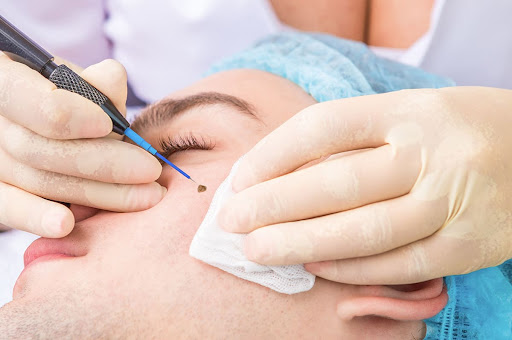Cauterization is a minimally invasive medical procedure used to remove unwanted tissues, lesions, or blood vessels through controlled burning or to stop bleeding. Assoc. Prof. Dr. Tuğba Falay Gür provides detailed information on how cauterization treatment is performed, its benefits, and the treatment process, helping patients achieve a healthier and more aesthetic appearance.
What is Cauterization?
Cauterization is the process of damaging tissue using thermal energy (heat). It is a non-surgical treatment typically performed under local anesthesia. Cauterization is commonly used to treat unwanted skin lesions, dilated blood vessels, warts, spots, and other dermatological issues.
Purposes and Goals
The main purpose of cauterization treatment is to safely and effectively eliminate unwanted tissue or blood vessels on the skin. The primary goals of the treatment include:
- Treatment of Dilated Blood Vessels: Reducing redness, red spots, and telangiectasia.
- Lesion and Acne Treatment: Removing warts, myxoid nevi, and other skin lesions.
- Reduction of Acne Scars and Fine Lines: Minimizing acne scars and fine lines.
- Control of Excessive Sebum Production: Regulating excessive oil production in the skin.
- Management of Combination and Oily Skin Issues: Balancing oil levels and reducing shine on the skin.
- Support for Skin Renewal: Promoting healthier and younger-looking skin.
How Cauterization Works
Cauterization treatment involves the use of controlled heat to burn and eliminate unwanted tissue or blood vessels. This procedure targets lesions or blood vessels on the outer layer of the skin, neutralizing them with thermal energy. Devices used in cauterization are generally categorized into two types:
- Electrocauterization: Heat is generated using an electric current, which is then applied to the tissue.
- Laser Cauterization: High-precision laser light is used to target and burn tissue.
Treatment Process
Cauterization treatment typically involves the following steps:
- Assessment: The doctor evaluates the skin type, location, and size of the lesion or blood vessel.
- Preparation: The area to be treated is cleaned and sterilized. Local anesthesia may be applied if necessary.
- Cauterization: The unwanted tissue or blood vessel is targeted and burned using an electrocauterization or laser device.
- Cooling and Soothing: Cooling methods may be used post-treatment to soothe the area.
- Aftercare: Special care recommendations, including moisturization and sun protection, are provided to support healing.
Benefits
The primary benefits of cauterization treatment include:
- Effective and Quick Results: Provides rapid and effective removal of unwanted tissue or blood vessels.
- Minimally Invasive: Does not require surgical intervention, reducing risks and recovery time.
- Natural Appearance: Achieves natural and aesthetic results in treated areas.
- Versatile Application: Targets various dermatological issues on the face, neck, décolleté, and other areas.
- Long-Lasting Results: Offers durable and permanent outcomes with proper application.
- Skin Renewal Support: Enhances healthier and more youthful skin.
Risks and Side Effects
Cauterization treatment is generally considered safe, but some side effects may occur:
- Temporary redness and swelling.
- Mild bruising and bleeding due to fine-needle use.
- Light discomfort or pain during the procedure.
- Temporary skin dryness.
- Irritation or redness, particularly in sensitive skin.
- Rare pigmentation changes (hypopigmentation or hyperpigmentation).
- Infection risk if hygiene is neglected post-treatment.
- Mild asymmetry due to needle application errors.
- Rarely, nodules or cysts from material accumulation.
- Potential allergic reactions to the materials used.
- Increased skin sensitivity in treated areas.
Who is Eligible?
Cauterization treatment may be suitable for individuals with:
- Dilated Blood Vessels: Reducing redness, red spots, and telangiectasia.
- Skin Lesions: Removing warts, myxoid nevi, and other skin lesions.
- Signs of Aging: Addressing fine lines, wrinkles, and sagging skin.
- Pigmentation Irregularities: Treating sunspots, melasma, and hyperpigmentation.
- Desire for an Aesthetic Appearance: Achieving a younger, firmer, and more aesthetic skin appearance.
- Non-Surgical Alternatives: Seeking less invasive treatments instead of surgical options.
- Sensitive Skin: Preferring gentler treatments over chemical peels.
Expected Results
After cauterization treatment, the following improvements can be observed:
- Tighter and Younger Skin: Improved skin elasticity.
- Reduced Wrinkles and Lines: Noticeable reduction in fine lines and wrinkles.
- Diminished Blood Vessels and Lesions: Significant reduction in visible blood vessels and skin lesions.
- Even Skin Tone: Balanced pigmentation for a more uniform skin tone.
- Smooth Skin Texture: Reduced texture irregularities for smoother skin.
- Youthful and Vibrant Appearance: Overall rejuvenated and aesthetic look.
- Improved Body Contours: Enhanced body contours through reduced fat deposits and treated blood vessels.
Cost and Sessions
The cost of cauterization treatment depends on the number of sessions required, treatment areas, and individual needs. While some treatments may be completed in a single session, multiple sessions may be needed for more noticeable and long-lasting results. A personalized treatment plan and cost analysis will be provided during a consultation with Assoc. Prof. Dr. Tuğba Falay Gür.
Prevention and Care
To maximize the results of cauterization and maintain skin health, consider the following:
- Sun Protection: Use broad-spectrum sunscreens to shield the skin from harmful UV rays.
- Gentle Skincare: Use mild cleansers, moisturizers, and avoid irritants.
- Balanced Diet: Eat a diet rich in antioxidants and omega-3 fatty acids.
- Regular Exercise: Promote circulation and overall health through physical activity.
- Quit Smoking and Reduce Alcohol Consumption: Both can negatively affect skin health and treatment outcomes.
- Stress Management: Practice stress-reducing techniques like yoga or meditation.
- Routine Skin Checks: Monitor your skin regularly and report changes to your doctor.
Skincare and Lifestyle
Proper skincare and a healthy lifestyle are crucial for the effectiveness of cauterization treatment:
- Use hypoallergenic cleansers.
- Regularly moisturize the skin.
- Eat a nutrient-rich diet with vitamins and antioxidants.
- Ensure adequate sleep.
- Stay hydrated by drinking sufficient water.
- Engage in regular physical activities.
- Practice stress management techniques.
Appointments and Contact
For more information about cauterization treatment, to evaluate options, and to receive expert advice, feel free to contact us. Benefit from the expertise of Assoc. Prof. Dr. Tuğba Falay Gür for healthier, younger, and more aesthetic skin.








